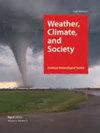你看到我看到的了吗?媒体选择和视觉龙卷风线索如何影响个人风暴准备
IF 1.9
4区 地球科学
Q3 ENVIRONMENTAL STUDIES
引用次数: 0
摘要
当龙卷风袭来时,几乎没有时间仔细思考所需物品的心理清单。这项研究试图了解龙卷风路径上的人们利用哪些信息来源进行准备,以及这些信息来源如何影响人们的行动。研究结果表明,电视和广播是最重要的两个信息来源,一些视觉图形——通过热图测量,以了解更高水平的恶劣天气准备——被报道是有用的。与气象意图相反,结果显示,当雷达显示龙卷风的位置和强度时,参与者不太可能为即将到来的天气做好准备。此外,那些在研究中对天气相关信息更感兴趣的人,以及那些担心未来龙卷风的人,更有可能做好准备。探索的每个变量都以计划行为理论和风险信息寻求与处理(RISP)模型为基础,以更好地理解行为意图和行动。这项研究提供了两个以前没有探索过的一般天气的新概念:兴趣和一般与特定风暴准备。本文章由计算机程序翻译,如有差异,请以英文原文为准。
Do you see what I see? How media choice and visual tornado cues influence individual storm preparation
When a tornado hits, there is little time to think through mental checklists for needed items. This study attempted to understand what information sources those in the path of tornados utilized for preparation and how those sources influence people to act. Results from the study indicate TV and radio are the top two information sources and some visual graphics—gauged via heat maps to understand higher levels of severe weather preparation—were reported as useful. Contrary to meteorological intentions, results showed participants were less likely to prepare for impending weather when radar displayed tornado locations and intensity. Additionally, those who identified as having more interest in weather-related information in the study were significantly more likely to prepare, along with those who fear future tornadoes. Each variable explored is underpinned by the Theory of Planned Behavior and the risk information seeking and processing (RISP) model to better understand behavioral intentions and actions. This study offers two new concepts of general weather not previously explored: interest and general versus specific storm preparation.
求助全文
通过发布文献求助,成功后即可免费获取论文全文。
去求助
来源期刊

Weather Climate and Society
METEOROLOGY & ATMOSPHERIC SCIENCES-
CiteScore
3.40
自引率
13.60%
发文量
95
审稿时长
>12 weeks
期刊介绍:
Weather, Climate, and Society (WCAS) publishes research that encompasses economics, policy analysis, political science, history, and institutional, social, and behavioral scholarship relating to weather and climate, including climate change. Contributions must include original social science research, evidence-based analysis, and relevance to the interactions of weather and climate with society.
 求助内容:
求助内容: 应助结果提醒方式:
应助结果提醒方式:


